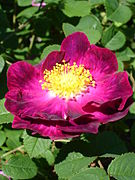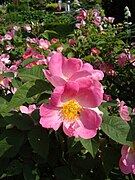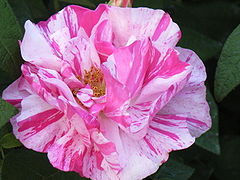Rosa gallica
| Rosa gallica | |
|---|---|

| |
| Wild Rosa gallica in Romania | |
| Scientific classification | |
| Kingdom: | Plantae |
| Clade: | Tracheophytes |
| Clade: | Angiosperms |
| Clade: | Eudicots |
| Clade: | Rosids |
| Order: | Rosales |
| Family: | Rosaceae |
| Genus: | Rosa |
| Species: | R. gallica
|
| Binomial name | |
| Rosa gallica | |
| Synonyms | |
|
Rosa portlandica Rössig[1] | |
Rosa gallica, the Gallic rose, French rose, or rose of Provins, is a species of flowering plant in the rose family, native to southern and central Europe eastwards to Turkey and the Caucasus. Rosa gallica was one of the first species of rose to be cultivated in central Europe.[2] It is a parent of several important cultivars.
Description[edit]
Rosa gallica is a deciduous shrub forming large patches. The slender, straight prickles are various in size and frequency in this species.[2][3] The leaves are pinnately-compound, with three to seven bluish-green leaflets. The flowers are clustered one to four together, on glandular pedicels. Each flower has five or more petals, sometimes producing double corollas.[2] The flowers are fragrant and deep pink. The hips are globose to ovoid, 10–13 mm diameter, and orange to brownish.
In the field of Food science, rose petal extract from Rosa gallica has been shown to have properties that reduce inflammation and wrinkling in human skin.[4][5]
Gallica cultivar group[edit]
Cultivars of the species R. gallica and hybrids close in appearance are considered as a cultivar group, the Gallica Group roses. Their exact ancestry is usually unknown and other species may be involved. They are easily cultivated. The Gallica Group roses share the vegetative characters of the species:
- forming low suckering shrubs,
- flowers can be single, but most commonly are double or semidouble,
- colours range from white (rare) to pink and deep purple, and
- once flowering
Apothecary's rose[edit]
Plants with semidouble deep pink flowers have been treated as either a variety, under the name R. gallica var. officinalis,[6] or as a cultivar, R. gallica 'Officinalis'.[7] It is also called the apothecary's rose, the crimson damask rose, or the red rose of Lancaster.[8] It is the county flower of Lancashire. A cultivar R. gallica var. officinalis 'Versicolor', with striped pink blooms, is also known as Rosa mundi.[9]
The names Rosa gallica f. trigintipetala or Rosa 'Trigintipetala' are considered to be synonyms of Rosa × damascena.[10]
Cultivation[edit]
It was cultivated by the Greeks and Romans and commonly used in mediaeval gardens. Until the 19th century it was the most important species of rose to be cultivated, and most modern European rose cultivars have at least a small contribution from R. gallica in their ancestry.[2]
Rosa gallica is easily cultivated on well drained soil in full sun to semishade; it can survive temperatures down to −25 °C.
The following cultivars and hybrids currently hold the Royal Horticultural Society's Award of Garden Merit.
- 'Beau Narcisse' (Mielles pre-1824)[11]
- 'Charles de Mills' (pre-1790)[12]
- 'Duc de Guiche' (pre-1810)[13]
- 'Duchesse de Montebello' (Laffay 1824)[14]
- 'Président de Sèze'[15]
- var. officinalis[16] (sometimes listed as a cultivar 'Officinalis', rather than a variety)
- 'Versicolor' ('Rosa mundi')[17]
- 'Tuscany Superb'[18]
Other notable cultivars include:
- 'Cardinal de Richelieu' (Parmentier pre-1847; withdrawn)[19] – this rose was used as a starting point for genetic engineering to produce the first blue rose[citation needed]
- 'Complicata'[20]
Gallery[edit]
-
'Alain Blanchard'
-
'Complicata'
-
'Ornament de la Nature'
-
'Versicolor' (Rosa mundi)
-
'Tuscany Superb'
References[edit]
- ^ "Rosa portlandica Rössig | Plants of the World Online | Kew Science". Plants of the World Online. Retrieved 4 February 2021.
- ^ a b c d "Rosa gallica". Go Botany. New England Wildflower Society. Retrieved 2018-10-07.
- ^ Clements, F. E.; Butters, F.K.; Rosendahl, C. O. (1912). "Minnesota trees and shrubs: an illustrated manual of the native and cultivated woody plants of the State". Report of the Botanical Survey. 9.
- ^ Lee, Myung-hee; Nam, Tae Gyu; Lee, Inil; Shin, Eun Ju; Han, Ah-ram; Lee, Pomjoo; Lee, Sung-Young; Lim, Tae-Gyu (2018-10-25). "Skin anti-inflammatory activity of rose petal extract (Rosa gallica) through reduction of MAPK signaling pathway". Food Science & Nutrition. 6 (8): 2560–2567. doi:10.1002/fsn3.870. ISSN 2048-7177. PMC 6261181. PMID 30510758.
- ^ Song, Young-Ran; Lim, Won-Chul; Han, Ahram; Lee, Myung-Hee; Shin, Eun Ju; Lee, Kwang-Min; Nam, Tae-Gyu; Lim, Tae-Gyu (2020-08-23). "Rose Petal Extract (Rosa gallica) Exerts Skin Whitening and Anti-Skin Wrinkle Effects". Journal of Medicinal Food. 23 (8): 870–878. doi:10.1089/jmf.2020.4705. ISSN 1557-7600. PMID 32609563. S2CID 220307850.
- ^ RHS Horticultural Database: Rosa gallica var. officinalis, Royal Horticultural Society, retrieved 2011-07-24
- ^ Phillips & Rix (2004), The Ultimate Guide to Roses : a comprehensive selection, London: Macmillan, ISBN 978-1-4050-4920-7
- ^ RHS A-Z encyclopedia of garden plants. United Kingdom: Dorling Kindersley. 2008. p. 1136. ISBN 978-1405332965.
- ^ "BBC plant finder - Rosa mundi". Retrieved 31 May 2013.
- ^ "Rosa gallica f. trigintipetala". Germplasm Resources Information Network. Agricultural Research Service, United States Department of Agriculture. Retrieved 2017-12-18.
- ^ "Rosa 'Beau Narcisse'". David Austin Roses. Retrieved 28 June 2021.
- ^ "Rosa 'Charles de Mills'". RHS. Retrieved 4 June 2021.
- ^ "Rosa 'Duc de Guiche'". RHS. Retrieved 28 June 2021.
- ^ "Rosa 'Duchesse de Montebello'". RHS. Retrieved 28 June 2021.
- ^ "Rosa 'Président de Sèze'". RHS. Retrieved 28 June 2021.
- ^ "Rosa gallica var. officinalis". RHS. Retrieved 28 June 2021.
- ^ "Rosa gallica 'Versicolor' (rosa mundi)". RHS. Retrieved 28 June 2021.
- ^ "Rosa 'Tuscany Superb'". RHS. Retrieved 28 June 2021.
- ^ "Rosa 'Cardinal de Richelieu'". RHS.
- ^ "Rosa 'Complicata'". RHS. Retrieved 28 June 2021.
External links[edit]
- Flora Europaea: Rosa gallica
- Huxley, A., ed. (1992). New RHS Dictionary of Gardening. Macmillan.
- Article on the use of RNAi technology to produce a blue rose





